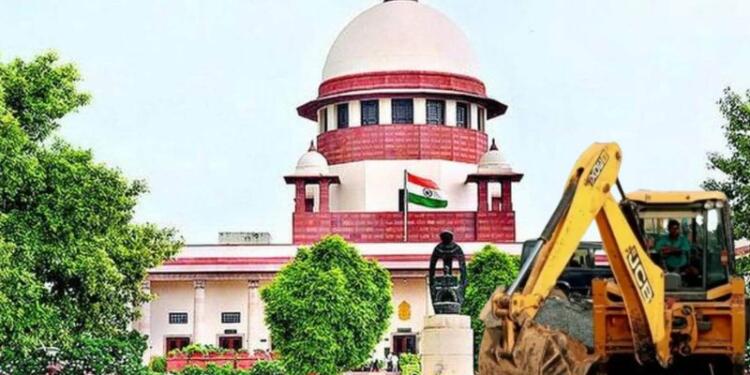On Wednesday (13th November), the Supreme Court of India laid clear guidelines for the local administrations to carry out bulldozer action against illegal constructions and encroachments. The key guidelines include 15-day advance notice, video recording of the demolition, and publicly displaying the spot report and ways to challenge the action legally, among other directives.
The bench comprising Justices BR Gavai and KV Viswanathan held that the authorities cannot determine the guilt or innocence of an accused and can demolish the accused’s residence as punishment.
The bench noted that the authorities can’t demolish the house of an accused or even convict citing his/her criminal background as such a demolition drive is “illegal” and “unconstitutional”.
The bench firmly noted that the responsibility to determine the guilt of a person and punish him vests with the judiciary.
It said, “If a property is demolished only because person is accused, it is wholly unconstitutional. Executive cannot determine who is guilty and cannot become a judge to decide if he is guilty or not and such an act will be transgressions of limits. The chilling side of bulldozer reminds that constitutional values and ethos do not allow such abuse of power.”
The court noted, “The executive cannot declare a person guilty, as this process is the fundamental aspect of the judicial review. Only on the basis of the accusations, if the executive demolishes the property/properties of such an accused person without following the due process of law, it would strike at the basic principle of rule of law and is not permissible. The executive cannot become a judge and decide that a person accused is guilty and, therefore, punish him by demolishing his residential/commercial property/properties. Such an act of the executive would be transgressing its limits.
It is pertinent to note that the guidelines will not apply on unauthorised structures illegally built on a public road, railway line, footpath, or water body, or if the demolition drive is being carried out in accordance with a court order.
The apex court categorically emphasised that the “executive cannot become a judge and declare an accused guilty and demolish his house”.
Here are the key directives laid by the Supreme Court for the pan-India demolition drive aka bulldozer action –
- Only structures found unauthorised will be demolished.
- Demolitions can only be carried out with advance notice to the owner. It must be prominently displayed on the said structure.
- The advance notice must be issued 15 days prior to the proposed bulldozer action. It must clearly specify the reason for demolition and the date of the hearing.
- The ‘owner’ of the said structure must be given a date for personal hearing and his/her submissions must be recorded.
- The hearing will decide whether the offence is compoundable or if partial demolition is possible.
- To avoid backdating, once the notice is issued, an auto-generated email must be sent to the Collector/District Magistrate.
- Within 3 months, a digital portal must be created. It will provide details of the notice and display the date of the notice pasted on the said structure.
- It must explain the necessity of razing the structure to the ground.
- The authorities must prepare a detailed spot report and do a video recording of the whole demolition drive and Police and officials must be present there.
- This spot report must be displayed on the digital portal.
- The violation of these directives will lead to prosecution for contempt or other legal action.
- If these guidelines are violated, the concerned officials will be held responsible for the restitution of property.































